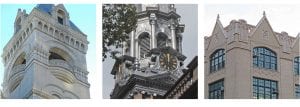
While efforts to make existing buildings “greener” tend to dominate the environmental conversation, the energy already embodied in those buildings should be higher on the sustainability agenda. Essentially, it’s the National Trust for Historic Preservation’s position that “the greenest building is one already built,” an assertion that SUPERSTRUCTURES has long subscribed to. Thomas de Monchaux’s recent article in Metropolis makes this case through a sophisticated look at the meaning of embodied energy and how it’s been factored into recent projects, from Google’s California headquarters to Brutalist housing blocks in Bordeaux.
As Monchaux puts it, “This way of seeing sustainability in the already-built environment is informed by the concept of embodied energy: an accounting, derived from models of economic and ecological systems, of the total expenditure of energy…associated with the life cycle of any given artifact.” He calls for a fundamental shift away from the disposability of modern buildings toward a new gospel of adaptive reuse, one that honors embodied energy as an “unnatural resource” we can’t afford to waste.
SUPERSTRUCTURES’ growing list of Lucy G. Moses Preservation awards from the New York Landmarks Conservancy (ten so far) attests to the firm’s commitment to preservation that maintains the embodied energy of landmark buildings while often improving their future performance.
If you’re intrigued by our mission to preserve New York City’s landmarks using state-of-the art tools and methods, consider joining our team of skilled, resourceful architects and engineers.
14 Wall Street, 25th Floor, New York, NY 10005
(212) 505 1133
info@superstructures.com
Subscribe to SuperScript, our email newsletter.